chief executive's Review
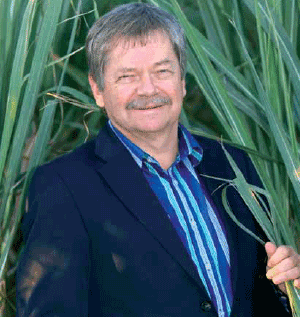
Peter Staude
Chief Executive Officer
Tongaat Hulett’s total sugar production for the 2011/12 year grew by 14% to 1,150 million tons. This included increases of 42% in Mozambique, 12% in Zimbabwe and 7% in South Africa. The cane supplied to all the sugar mills grew to 9,6 million tons, with significant momentum building in the various on-going cane supply initiatives. The starch operations benefitted from world competitive maize costs and improved co-product recoveries. An increasing number of hectares of land are moving towards becoming active developments, with the first sales of industrial land in Cornubia having been concluded in March 2012.
Revenue for the year of R12,081 billion was 24,8% above the prior year, mainly as a result of increased sugar production together with improved realisations in the regional and European Union sugar markets. The total profit from the various operating areas grew by 53% and exceeded R2 billion for the first time. Headline earnings grew to R891 million (2011: R806 million).
The year to 31 March 2012 has seen Tongaat Hulett making significant progress with a number of its key strategic thrusts. The company’s achievements in the recent past provide a strong indicator of the benefits that will flow to the business and its stakeholders as it continues to deliver on its short and medium term targets:
Grow sugar production from the 1 million tons produced in recent seasons to the installed milling capacity which is in excess of 2 million tons per annum.
-
Tongaat Hulett’s strategy is to facilitate an increase in cane supplies to grow sugar production. New plantings in the past year increased the area under cane by 13 522 hectares and the replanting of existing roots is being accelerated for the benefit of future milling seasons. These additional hectares, together with improvements in cane yields and the cane to sugar ratio, will assist the business to grow its sugar production by more than 50 percent to some 1,73 million tons sugar by the 2014/15 season.
-
Assuming normal weather conditions, it is anticipated that the extent of land being farmed in the 2014/15 season to supply Tongaat Hulett mills, will increase by some 20 percent to just over 233 850 hectares from the current season’s 194 652 hectares. The land that is harvested for milling will grow by approximately 23 percent to just over 192 227 hectares from the current season’s 155 677 hectares.
-
One of the key requirements to increase the quantum of sugarcane supplies to the mills is the replacement of old roots. The South African and Zimbabwean operations still require extensive root replacement and therefore there will continue to be significant investments in new roots for at least the next 2 planting seasons. This intervention together with applying optimal farming practices will have a substantial impact on improving yields.
-
Numerous cane supply initiatives are underway in the various sugar operations through leasing land, working with private farmers and collaborating with Governments to rehabilitate cane supply and land reform farms that have gone out of cane.
-
By the 2014/15 season some 37 and 24 percent of the businesses sugarcane supplies for its Zimbabwe and Mozambique operations respectively will be supplied by land that is farmed by private farmers. In South Africa, the extent of land supplying Tongaat Hulett mills, that benefit from the company’s direct involvement and mentoring will grow from 34 percent in the 2011/12 season to 47 percent in the 2014/15 season. During the same period the extent of hectares that is farmed by commercial farmers that supply Tongaat Hulett operations will remain fairly constant at just over 85 000 hectares.
-
The increase in revenue that will flow to private farmers as they increase the supply of sugarcane to Tongaat Hulett mills will continue to have a positive impact on the towns and communities that surround company operations. During the year to 31 March 2012, R1,8 billion was paid to private farmers who supplied the business’s sugar operations with cane.
-
The extent of additional cane plantings is decided only once an assessment of the yields that can be achieved on the new hectares has been completed. Due to the nature of the sugarcane crop, the cash flow benefit from the subsequent raw sugar sales will be realised some 18-24 months after in the investment in roots.
-
The focus remains on increasing the sugar that is contained in and extracted from the cane stalk, through improved farming practices, suitable fertilizer application, appropriate irrigation of cane, harvesting of cane at the correct age which is normally every 12-13 months and better mill performance.
-
Between 85-90 percent of sugar milling costs are fixed and approximately 78 percent of agricultural costs are directly linked to the extent of hectares being farmed, while 15 percent are fixed. The business will continue to ensure that it optimises the tons cane per hectare (tcph) that is derived from land that is under sugarcane. Loading and transport costs vary depending on the distance to the sugar mill, and generally mills are supplied by sugarcane that is farmed within a 100 kilometer radius. The growth in sugarcane supplies and subsequently sugar production will lead to a substantial reduction in the unit cost of production.
-
Current estimates indicate that the construction of a greenfield irrigated sugar business, comprising both agricultural and milling operations for the production of 200 000 tons sugar per annum, with the power supply limited to milling operations, will require R4,8 billion of investment or R24 000 per ton of sugar.
-
Tongaat Hulett anticipates that, assuming normal weather conditions, it will produce some 1,83 million tons sugar by the 2015/16 season. This equates to an increase of 685 000 additional tons of sugar production when compared to the 2011/12 production of 1,15 million tons. In order to achieve this targeted production a further investment of R1,8 billion by Tongaat Hulett and third parties will be required for investment in new and replacement roots, infrastructure spend on rural private farmer communities and upgrading of existing milling operations. This equates to an investment of some R2 627 per additional ton of sugar.
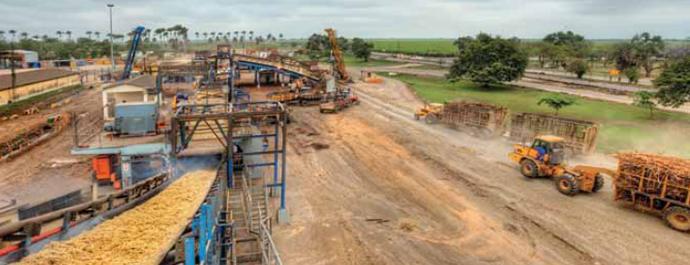
Cane crushing at Xinavane Mill
Significantly progress Tongaat Hulett’s renewable energy initiatives to meet South Africa and the SADC region’s need for agricultural development, job creation, energy security and climate change.
-
Partner with SADC Governments to develop regulatory frameworks that will facilitate renewable electricity generation from sugarcane fibre and the production of ethanol from sugar on a commercial basis. In looking at both of these energy products, Tongaat Hulett continues to advocate a regional approach, which ultimately will support production in all of the countries in which the company operates.
-
Progress is being made with the South African Government in terms of the procurement process for renewable electricity. Tongaat Hulett currently produces 52 MW at its 4 South African mills and this can be increased to between 320 MW - 360 MW. The capital cost of converting one sugar mill, together with making it energy efficient will currently cost some R3 billion.
-
The development of a biofuel industry in the region is gathering momentum in various SADC countries. This could mean that in the future, a substantial portion of Tongaat Hulett’s raw sugar exports are diverted to ethanol production. Converting the current South African Industry’s export sugar would result in a 5 percent blend that is equivalent to 600 million litres of ethanol per annum. The South African fuel market is 12 billion litres of petrol per annum. If Tongaat Hulett converted 1 of its 4 South African mills to ethanol it would require an investment of approximately R700 million and would produce some 125 million litres per annum.
Maximise the speed and value to all stakeholders of land conversion from agricultural land to property development through a portfolio approach, including own developments, partnerships and bulk sales.
-
Tongaat Hulett maximises the value of its landholdings to all stakeholders by optimising land use between agriculture supplying its agri-processing operations and other uses through its property development activities as competition for alternative land usage increases. The transition of prime land from agriculture to property development with the established conversion platform and expertise generates both capital and operating profits.
-
All land sale options are evaluated on an ongoing basis and the concepts available for land sales continue to include bulk deals / partnerships / own developments.
-
In South Africa, some 8 600 developable hectares (13 607 gross hectares) of company managed land have been identified for conversion to other uses when conditions are appropriate.
-
A primary focus of the developments operation is to increase the number of hectares of land that are becoming active developments by aligning planning with Government policies and achieving EIA, zoning and other necessary approvals over significant portions of the land portfolio. The extent and pace of these processes has increased substantially and it is anticipated that by December 2014, Tongaat Hulett will have more than 1 000 developable hectares of zoned land, ignoring further land sales until that date.
Optimise the performance of the starch and glucose operation, maize procurement and production efficiencies.
-
The structural changes taking place in international agricultural commodity markets have resulted in the improved competitiveness of the South African maize industry and consequently, Tongaat Hulett’s starch operations. This operation can increase production, from installed milling capacity, by a further 20 percent, creating opportunities for growth into Africa.
-
The key areas of focus for the starch operations remains on optimising production capacity, particularly in downstream channels and identifying further opportunities to improve plant efficiencies.
Assist with the development of small-scale private farmers thereby contributing to the creation of successful rural communities around the business’s areas of operation.
-
Tongaat Hulett is continuing in its e orts to grow the number of indigenous sugarcane farmers. In the 2011/12 season some 870 private farmers on 9 501 hectares in Zimbabwe supplied cane to the milling operations. In Mozambique, some 1 759 indigenous private farmers on 2 878 private and leased hectares supplied sugarcane to Tongaat Hulett operations.
-
The company is continuing with its e orts to increase the support that it provides to small-scale sugarcane private farmers in South Africa, with the business’s partnership through Operation Vuselela being an example of the model underway in order to contribute to skills transfer and the development of previously unemployed rural community members.
Continue to develop strong relationships with Tongaat Hulett’s stakeholders.
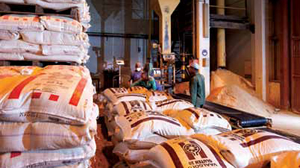
Starch and Glucose, Meyerton Mill
-
Tongaat Hulett has a shareholder base that includes many Southern African and international long-term value investors. The business has over many years established strong relationships with its shareholders, and continues to participate in both local and international roadshows in order to ensure that both current and potential shareholders are kept informed of developments within the company.
-
As part of the company’s Broad Based Black Economic Empowerment deal in 2007, the Ayavuna and Sangena consortiums, rural communities via the Masithuthukisane and Mphakhathi trusts and company employees via the ESOP and MSOP trusts, became shareholders of Tongaat Hulett. The ESOP and MSOP trusts are scheduled to vest in August 2012, while vesting of the remaining trusts is scheduled for August 2014.
-
The business’s South African operations are increasingly seeing that benefit that can be derived from working more closely with the commercial farmers who farmed 85 044 hectares of sugarcane land that supplied Tongaat Hulett mills during the 2011/12 season. During the year to 31 March 2012, the company implemented an R11,3 million scheme which assisted commercial farmers to replant some 1 612 hectares of land where the roots were older than 10 years.
Maximise the benefit of owning the leading sugar brands and strong distribution networks in the SADC region.
-
The South African sugar market is the largest in the Southern African Customs Union (SACU) and the per capita consumption of sugar in South Africa has grown by 11 percent since 2006. Tongaat Hulett with its leading Huletts® brand is well positioned to continue benefiting from any further growth in domestic consumption.
-
In Botswana, the company’s leading Blue Crystal® brand has benefited from the 18 percent growth in per capita sugar consumption since 2006.
-
The company’s Marathon® brand is the leading sugar brand in Namibia.
Strive towards establishing an organisational culture with a zero harm approach.
- The Lost Time Injury Frequency (LTIFR) remained at 0,10 per 200 000 hours worked in 2011/12, and regrettably two employees lost their lives in two separate work related accidents. Robert Mpunzi and Inacio Elias Guambe, who were both employed as drivers lost their lives in incidents which occurred at the Triangle and Xinavane operations respectively.
Continue to make good progress in the areas of safety, health, environment, community and Government relationships.
- This, together with the commitment to sound corporategovernance,isconsistentwiththeprinciples embodied in the King III corporate governance framework.
FINANCIAL AND OPERATIONS REVIEW
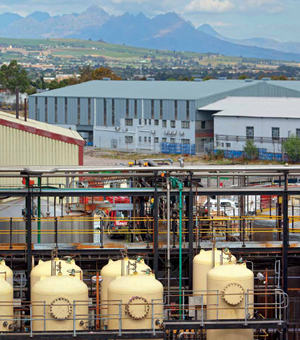
Starch and Glucose - Bellville Mill
Revenue grew to R12,081 billion (2011: R9,681 billion) with improved sugar volumes and realisations. The profit from the various operating areas increased to R2,006 billion (2011: R1,309 billion) reflecting the benefit of increasing utilisation of existing sugar milling capacity together with other advances across the business operations.
Profit from the starch operations increased by 20% to R363 million, compared to R303 million last year.
Improved co-product revenues and local maize costs that were previously contracted below Chicago (CBOT) prices resulted in an improvement in starch and glucose processing margins. Manufacturing plant performance has continued to improve and sales volumes in the local market were 1,4% above last year.
MAIZE PROCUREMENT
The final maize crop estimate for the 2010/11 season amounted to 10,4 million tons (2009/10: 12,8 million tons). Higher international maize prices and global supply concerns encouraged an increase in the area planted to maize in South Africa to 2,70 million hectares (2010/11: 2,38 million hectares) in the current summer crop production season. The export drive during the prior season which reduced the levels of carry in stock combined with some damage that was reported due to dry conditions experienced during the growing season have resulted in a decline in maize stock to use ratios. The crop for the current season is estimated at 11,1 million tons which should ensure that supply exceeds local demand for a fifth consecutive season.
Physical maize requirements of non-genetically modified maize for Tongaat Hulett continue to be secured through a combination of contracting directly with farmers and contracting for delivery with selected grain traders. The physical supply for the remainder of the season to June 2012, and the requirements for the period July 2012 to May 2013 have been contracted.
Maize pricing is delinked from the physical supply utilising either a toll manufacturing arrangement or a back-to-back pricing approach. Utilising a combination of these methods, exposure to future movements in the maize price has been reduced with approximately 59 percent of the 2012/13 financial period’s maize requirements forming part of the above pricing approaches at March 2012. The use of a third hedging mechanism, which secures the local price of maize at a level relative to the international price, was increased during the season. When the South African maize price trades at levels above those of the Chicago Board of Trade (CBOT), margins in the business come under pressure.
LOCAL MARKET
Domestic starch and glucose volumes increased by 1,4% over the prior year with economic growth affected by the Euro zone issues and local consumer demand. Sectors which were worst affected, recording a decline in volumes, were the coffee creamer and canning sectors. These declines were compensated for by growth in the confectionary sector due to increased demand arising from the establishment of new local manufacturing facilities. The pharmaceutical sector reflected a 13,5% growth as sorbitol market share was recaptured from glycerine in the tooth paste manufacturing sector. Volumes in the trader sector grew by 46,7% with a renewed focus on replacing imports within this sector.
New product development of high margin modified food starches in the domestic and export market is continuing with commercialisation planned for the second half of 2012. The development of starch-based adhesives continued and reflected growth of 21,7% over the previous year. Extension of the range of starch based adhesives for sacks and laminates is continuing.
COST MANAGEMENT, EFFICIENCIES AND CAPACITY UTILISATION
On-going management focus on all areas of manufacturing efficiency, particularly the areas of energy usage and steam generation, yielded positive results and resulted in cost reductions. The replacement of some major items of capital equipment is scheduled for completion during the first quarter of the new financial year and further gains are expected because of this work. A benchmarking exercise to highlight further opportunities commenced during the latter part of the year.

Xinavane Mill
The Zimbabwe sugar operations generated profit of R621 million (US$84 million) compared to the previous year of R454 million (US$63 million). Sugar production in Zimbabwe increased by 12% to 372 000 tons (2011: 333 000 tons), with the majority of the increase coming from Hippo Valley. The business benefitted from higher export realisations.
In Zimbabwe, Tongaat Hulett has embarked on a comprehensive private farmer rehabilitation programme named Successful Rural Sugar Cane Farming Community Project (SusCo). The joint patrons of the project are the Vice President of Zimbabwe, the Honourable Joice Mujuru and the Tongaat Hulett CEO. The goal of the SusCo Project is to facilitate private farmers, with the support and expertise of Tongaat Hulett, to increase their supply of sugarcane. The project will re-establish the private farmer sugarcane production area from its current 9 501 hectares to 15 880 hectares with an anticipated improvement in yields from 59 tcph to at least 90 tcph by the 2014/15 season. BancABC in Zimbabwe has provided funding through the establishment of a 4-year revolving US$30 million financing scheme for the sugarcane farmers. For the 12 months to 31 March 2012, 3 476 new and replant hectares were planted to cane under the auspices of the SusCo project. In addition, private famers using their own funding lines planted a further 1 974 new and replant hectares to cane.
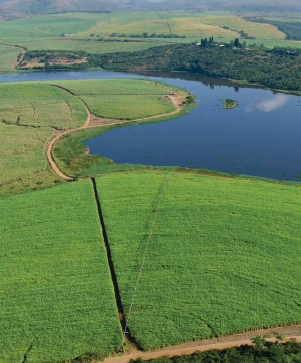
Sugarcane farm in KwaZulu-Natal
The SusCo project is an example of Tongaat Hulett’s commitment to meaningful stakeholder value creation, and demonstrates the value that can be derived from partnering with Governments and rural communities. The direct beneficiaries of the project include hundreds of private sugarcane farmers from the Hippo Valley, Triangle and Mkwasine Mill Group areas. As a result of the project, the number of people employed by private farmers will increase from approximately 3 600 employees, currently employed, to some 6 300 employees.
In addition to Tongaat Hulett’s initiatives in this area, the European Union Adaptation Funding Programme provided €9,2 million to rehabilitate infrastructure and the replanting of 1 200 hectares of private farmer cane in Zimbabwe. During the 12 months ended 31 March 2012, 874 hectares were planted to cane, with a further 80 hectares scheduled to be planted during the 2012/13 season.
Profit from the Mozambique sugar operations grew by 198% to R402 million (2011: R135 million), with sugar production having grown by 42% to 233 000 tons (2011: 164 000 tons). Following the previous expenditure on establishing the cane, it is now being harvested and the sugar produced and sold, with the operating cash flow in Mozambique having increased by more than R400 million over the previous year. The operations benefitted from higher export realisations and domestic prices in line with regional pricing levels.
The Mozambique operations saw substantial growth in sugar production as a result of the increase in hectares being harvested at improved cane yields. For the year to 31 March 2012, 24 555 hectares were harvested and delivered with a cane yield of 80,4 tcph. As the business continues to focus on the Cane Yield and Sucrose Improvement Plans at its operations, it is anticipated that the hectares milled will grow to 26 849 hectares with a cane yield of 93,6 tcph in the 2014/15 season.
At Xinavane estate a total of 2 598 hectares on privately owned and leased land is under sugarcane for small and medium scale farmers for delivery of cane, to its factory for crushing. The areas are comprised of groups and/or associations of farmers. Prior to the recently completed private grower developments there have been four long standing associations with a total of 478 hectares under sugarcane that had been developed under government-supported donor projects. These schemes have 366 members with an average of 1,3 hectares between them. 5 Medium scale farmers on 375 hectares of land, supply cane to the Xinavane Mill.
As part of its sugar production expansion program which commenced in 2007 Xinavane has supported and funded the development of new sugarcane farmers on the surrounding community lands comprising 12 new associations with a total area of 1 365 hectares and 8 medium scale farmers with a total of 380 hectares. The 12 small scale farmers’ associations have 1 373 members, who each own a share of land ranging from 0,4 to 3,5 hectares. The size of the medium scale farms range from 14 to 45 hectares. The lands for the small and medium scale farmers are now fully developed and planted and is being managed by estate sta in the initial phase to allow training and skills development of the local farmers before they take over the management of their farms. 108,5 hectares has also been developed for food crops under full irrigation as part of a food security initiative.
The Mafambisse operation has 7 private farmers supplying cane from 280 hectares of land.
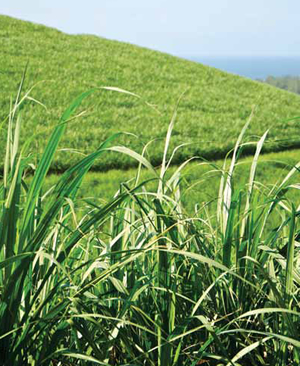
Sugarcane field - KwaZulu-Natal North Coast
Operating profit from the South African sugar operations including the downstream sugar value added activities increased by 51% to R354 million (2011: R234 million). Raw sugar production increased by 7% to 486 000 tons (2011: 455 000 tons). The gap between the hectares under cane and the hectares milled was unusually large as a result of the substantial cane root planting following the drought in the previous two years and the approximate 15 month lead time required from planting to first harvesting. New cane planting driven by Tongaat Hulett in the last year totalled 8 687 hectares, following the 9 696 hectares planted in the previous two years. Sales by Tongaat Hulett into the local market increased by 10%. Tongaat Hulett’s share of industry production increased from 23% to 26%.
The operation’s sugarcane planting interventions were primarily driven through planting initiatives on communal land that involved seed cane subsidies, Project Vuselela (revival in Zulu) as well as leases and farm management contracts on commercial farms. The company has identified additional expansions of the area under cane, with at least 9 506 hectares being planned for the 2012/13 planting period. The land under sugarcane supplying Tongaat Hulett mills is targeted to reach 159 259 hectares by the 2014/15 season. The average yield during the 2011/12 season was 47,3 tons cane per hectare milled and management have targeted to increase yields to 55,9 tons cane per hectare milled by the 2014/15 season, assuming normal weather conditions.
Tongaat Hulett has signed a three year partnership agreement with the National Department of Rural Development and Land Reform to rehabilitate some 65 land reform farms in the Tongaat Hulett cane catchment area. In terms of the agreement, the Government will contribute some R66,6 million over the partnership term, and during the period to 31 March 2012, some R34,9 million was received to fund activities related to the rehabilitation process.
Operating profit in the South African agriculture, sugar milling and refining operations started recovering and improved to R93 million (2011: loss of R7 million). The various downstream sugar value added activities recorded profit of R261 million (2011: R241 million). The Voermol animal feeds operation experienced pressure on sales volumes and margins.
In Swaziland, the Tambankulu sugar estate’s operating profit recovered to R51 million (2011: R17 million), returning to 2009/10 levels. The raw sugar equivalent production increased to 59 000 tons (2011: 54 000 tons), with higher cane yields and sucrose content being achieved. Export pricing levels improved, as did exchange rates. Tongaat Hulett acquired the business in 1998 and for the year to 31 March 2012, the operation achieved its highest recorded yields, sucrose content and sugar production.
In the land conversion and development activities, various sales strategies (bulk sale, partnership or own development) are constantly reviewed for each land holding and implemented as appropriate. Offers for bulk and semi-bulk land sales received over the past two years that did not represent optimal value were turned down. Revenue was generated from 22 developable hectares sold in Cornubia and a further 20 developable hectares that were sold primarily in the Umhlanga Ridge, Zimbali, Bridge City and Izinga areas. Operating profit grew by 30% to R215 million (2011: R166 million) with a further R3 million in capital profits (2011: R23 million) being realised.
Tongaat Hulett has over an extended period of time developed the necessary skill and expertise required to enhance the value of land as it transitions from agricultural land to property development. Preparing agricultural land to becoming an active development requires a number of overlapping processes involving local, provincial and national Government departments. These include strategic spatial planning by the local authorities, framework planning, environmental impact assessments, rezoning, release from agriculture and from mining, water licencing by the department of water a airs, confirmation of all necessary bulk infrastructure and sub-divisional approvals.
The “centrally accounted and consolidation items” component of the income statement reflects the e ect of the pension fund employer surplus account allocation of 2010/11 not being repeated in 2011/12. Profit from operations, after centrally accounted items, grew by 43,6% to R1,921 billion.
Finance costs increased to R507 million from R472 million in the 2011/12 year and are commensurate with the level of borrowings.
Operating cash flow, before working capital, improved by R863 million to R1,757 billion for the year. This follows the previous absorption of cash in the various expansion and on-going sugar cane establishment programs. The net cash outflow, after dividends, of R293 million reflected an improvement of R534 million over the prior year. Tongaat Hulett’s net debt at 31 March 2012 was R4,404 billion. A first long-term bond issuance of R750 million was successfully concluded.
Total net profit was R1,021 billion (2011: R871 million). The gain in respect of the pension fund accounting of R288 million and the R129 million employer surplus account allocation in the prior year did not arise again in the current year. The minority shareholders’ interests increased to R132 million (2011: R38 million) as a result of higher profits at the sugar milling operations in Mozambique and at Hippo Valley in Zimbabwe. Headline earnings were R891 million, compared to the R806 million earned in the prior year.
The Board has declared a final dividend of 170 cents per share, bringing the annual dividend to 290 cents per share (2011: 250 cents per share).
CONCLUSION
OUTLOOK
Tongaat Hulett’s drive to increase the cane available for its mills is continuing to build momentum (including hectares under cane, yields and cane quality), towards fully utilising its existing milling capacity of more than 2 million tons of sugar. At full capacity utilisation, sugar production would increase by more than 75% over the 1,150 million tons of the 2011/12 season. Unit costs will benefit substantially from increasing volumes and yields, as milling costs are mostly fixed and many of the agricultural costs are fixed per hectare, countering the effect of current cost pressures including wage increases.
The strategy to increase cane supply in South Africa is focused on commercial farmers, small scale farmers and increasing Tongaat Hulett’s influence in cane development through leasing additional land and collaborating with Government to rehabilitate cane supply on land reform farms that have gone out of cane. The gap between hectares under cane and hectares milled will remain a feature of the next three years as a result of accelerated root replanting to improve cane age, generate better yields and increase the crop’s ability to withstand variable weather conditions. Hectares available for milling in 2012/13 will increase as a result of the 9 696 hectares which were planted in the 2009/10 and 2010/11 years. The additional 8 687 hectares that were planted in the 2011/12 season in the catchment areas of Tongaat Hulett’s South African mills will largely be harvested for the first time in the 2013/14 season.

Magistrate Court, Bridge City (Ntuzuma, KwaZulu-Natal)
Co-operation between the Zimbabwe Government, the eastern lowveld communities and Tongaat Hulett is focused on the “Successful Rural Sugar Cane Farming Community” project. Some 15 900 hectares have been allocated to approximately 870 indigenous farmers. In this past season, these farmers delivered 532 000 tons of cane (equivalent to 65 000 tons of sugar) from some 9 000 hectares. The target is to uplift this to over 1,4 million tons of cane (equivalent to 180 000 tons of sugar) from the available hectares, with the pace of planting new roots being targeted to average some 4 000 hectares per annum. It is thus pleasing that some 6 000 hectares were planted in the 2011/12 year. This, together with Tongaat Hulett’s improvement of its own agricultural yields, is key to achieving the target of increasing sugar production in Zimbabwe to full milling capacity of some 640 000 tons per annum.
Sugar production in Mozambique is expected to grow by a further 30% over the next three years to above 310 000 tons per annum together with a reduction in unit costs.
High levels of South African maize exports in the past season and dry weather conditions during the current maize season have resulted in local maize prices rising to levels slightly above international maize prices and this is expected to place some pressure on starch margins. Exposure to future movements of the maize price in the forthcoming year has been reduced with 59% of maize requirements having been priced with customers or hedged below the international maize price.
Tongaat Hulett has targeted some 8 600 developable hectares (13 607 gross hectares) for development in South Africa. There are on-going processes on most of the developable land to enhance its usage and value to all stakeholders. The extent and pace of planning, in collaboration with Government, has increased substantially. Cornubia industrial (80 hectares still to be sold) and Sibaya node 1 (49 hectares) have recently become available for sale. Tongaat Hulett continues to explore bulk land sale opportunities within its land holdings. The exact timing of land sales, including bulk sales, remains variable in the current economic climate.
Overall, as one of the main drivers of revenue and earnings, sugar production is expected to increase by between 12% and 25% in the 2012/13 season. It is anticipated that regional sugar prices will be stable and export realisations into the European Union should remain attractive, with the business’s direct exposure to the more volatile world sugar market being of the order of 10%. Tongaat Hulett’s financial results remain sensitive to movements in exchange rates, which impact particularly on export realisations and the conversion of profits from Zimbabwe and Mozambique into Rands.
The future revenue stream would benefit significantly from electricity and ethanol developments. Tongaat Hulett continues to interface with Government towards establishing an appropriate regulatory framework for both electricity generation and ethanol production from sugarcane.
ACKNOWLEDGMENTS
I would like to acknowledge and pay tribute to the more than 42 000 employees who on a daily basis give their energy, e ort and commitment to Tongaat Hulett as the business endevours to deliver on its strategic thrusts. Tongaat Hulett’s 27 sites include a significant agricultural and agri-processing footprint in the rural areas of Mozambique, Swaziland, Zimbabwe and the North Coast of KwaZulu-Natal and the company is cognisant of the many farming and rural communities who are directly impacted by our operations. The business is committed to working together with private farmers, rural communities and Governments to grow our contribution to stakeholder value creation.
Tongaat Hulett regularly interfaces with the investment community and the business values the support that it has received from its existing long-term shareholders as it progresses the delivery of its strategic objectives.
The ongoing support and guidance that we have received from the Board is highly valued. Our appreciation is extended to Mac Mia for the contribution that he has made during his 15 years on the board. Tongaat Hulett is in the fortunate position that it has a Chairman of the quality and calibre of JB Magwaza. His calmness and insight on a number of strategic matters continue to highlight the contribution that he is making to the business.

PETER STAUDE
CHIEF EXECUTIVE OFFICER
Amanzimnyama
Tongaat, KwaZulu-Natal
24 May 2012




